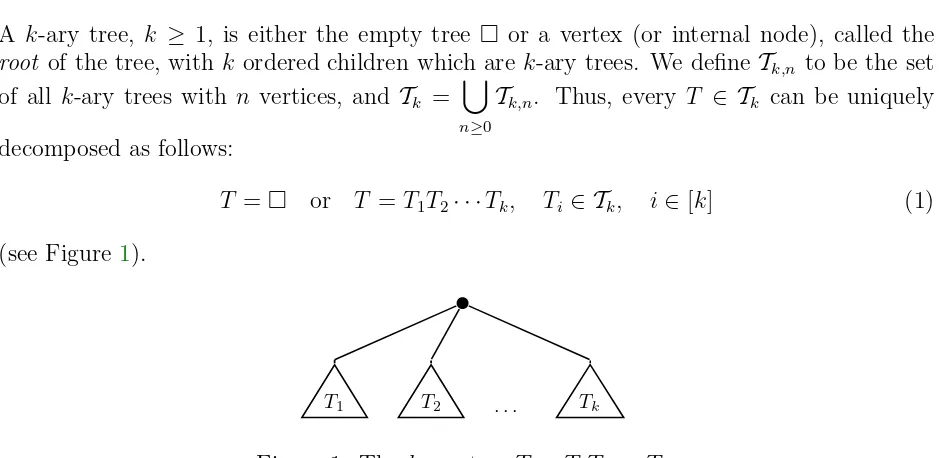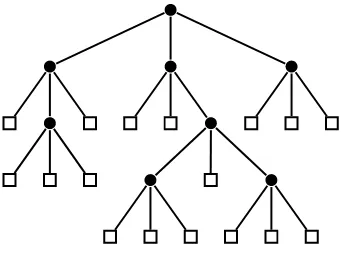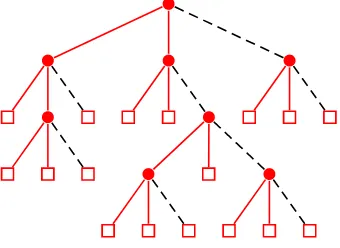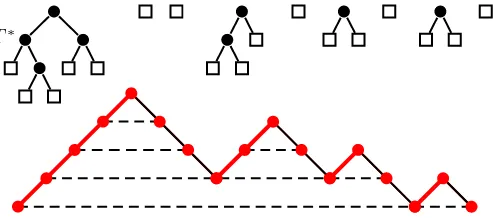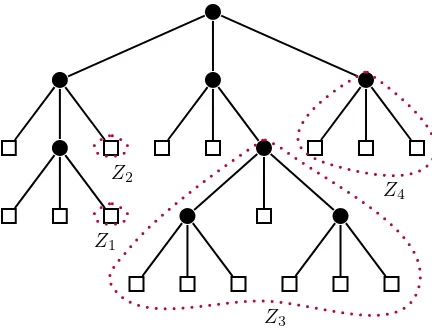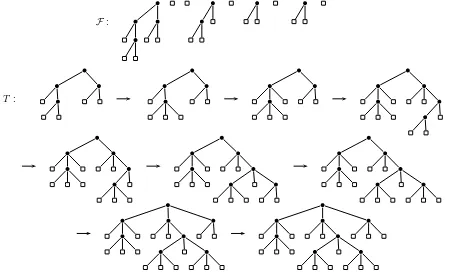23 11
Article 09.7.7
Journal of Integer Sequences, Vol. 12 (2009), 2
3 6 1 47
Recursive Generation of
k-ary Trees
K. Manes, A. Sapounakis, I. Tasoulas and P. Tsikouras
Department of Informatics
University of Piraeus
18534 Piraeus
Greece
[email protected]
[email protected]
[email protected]
[email protected]
Abstract
In this paper we present a construction of everyk-ary tree using a forest of (k− 1)-ary trees satisfying a particular condition. We use this method recursively for the construction of the set ofk-ary trees from the set of (k−1)-Dyck paths, thus obtaining a new bijection φ between these two sets. Furthermore, we introduce a new order on [k]∗ which is used for the full description of this bijection. Finally, we study some new statistics on k-ary trees which are transferred by φ to statistics concerning the occurrence of strings in (k−1)-Dyck paths.
1
Introduction
The notion of k-ary trees has been studied extensively in the literature. Some authors deal with the generation of k-ary trees using some encoding of them as integer sequences, which are generated in a specific order (see for example [3, 10, 11, 17, 20, 21]). In another direction k-ary trees are related to other k-Catalan structures such as staircase tilings, the tennis ball problem, noncrossing contractions and K-trees (see for example [6,7,12,13,14]). Finally, there are some papers dealing with the enumeration ofk-ary trees according to some parameters (see for example [5, 19, 22]).
A well known procedure for the study of trees contained in a certain setT is to introduce a decomposition of these trees with respect to the size and then, using this decomposition, to rebuild T from trees of smaller size.
trees satisfying certain properties and we show how these trees can be reconstructed from the associated forest. Next, by introducing an operation on forests, we present a recursive construction (in terms of k) of Tk using unary trees, thus obtaining a new bijection from k-ary trees to (k−1)-Dyck paths.
In Section 2we give some definitions and preliminary results.
In Section 3 we associate every k-ary tree with a forest of (k −1)-ary trees such that the path with ascent sequence consisting of the sizes of the trees in this forest is a Dyck path. Conversely, every such forest generates the tree uniquely; consequently an algorithmic construction is given.
In Section4, the method used in the previous section is applied recursively for everyk-ary tree, and terminates with a forest of unary trees such that the path with ascent sequence consisting of the sizes of the trees in this forest is a (k −1)-Dyck path. Conversely, this forest generates the tree uniquely, so that a new bijection φ between Tk and the set of all (k−1)-Dyck paths is obtained.
In Section 5we fully describeφ, by introducing a new order on the set of maximal paths of the k-ary tree.
Finally, in Section 6 we enumerate the set Tk according to some parameters related to the notions of the previous sections.
2
Preliminaries
A k-ary tree, k ≥ 1, is either the empty tree or a vertex (or internal node), called the
root of the tree, withk ordered children which are k-ary trees. We define Tk,n to be the set of all k-ary trees with n vertices, and Tk =
[
n≥0
Tk,n. Thus, every T ∈ Tk can be uniquely
decomposed as follows:
T = or T =T1T2· · ·Tk, Ti ∈ Tk, i∈[k] (1)
(see Figure1).
T1 T2
· · · Tk
Figure 1: The k-ary tree T =T1T2· · ·Tk.
An empty child of a vertex is called a leaf (or external node) of the tree. The size of a k-ary treeT is the number of its vertices and it is denoted by s(T); (see for example Figure 2).
Figure 2: A 3-ary tree of size 8.
It is well known (see for example [8], p.589) that |Tk,n| is equal to the n-th k-Catalan number
We note that Cn(2) are the ordinary Catalan numbersCn ([15], A000108). Furthermore, the generating function Ck(x) = Pn≥0C
(k)
n xn of the k-Catalan sequence satisfies the equation
Ck(x) = 1 +x(Ck(x))k,
from which it can be easily shown using the Lagrange inversion formula ([2], Appendix A) that the coefficients of (Ck(x))s, s∈N, are given by the formula
Every non-empty (k−1)-ary tree can be considered as a k-ary tree which has all itsk-th children empty.
A maximal (k − 1)-ary subtree of a k-ary tree T is any tree obtained by choosing a k-th child inT (or T itself) and by deleting every k-th child in it. Obviously, two maximal k−1-ary subtrees of T are disjoint; (see for example Figure 3).
Consequently, if T has n vertices, then it contains n+ 1 maximal (k−1)-ary subtrees. A (totally ordered)forest of k-ary trees is an elementF of the cartesian product Tλ
Figure 3: The 3-ary tree of Figure 2 and all its binary maximal subtrees.
For every i-pathP we denote by r(P) (respectively f(P)) the number of rises (respectively falls) of P. An i-Dyck path is an i-path that never falls below the x axis and ends at the x axis. IfP is ani-Dyck path, thenf(P) = i·r(P) andP ends at the point ((i+1)r(P),0). We will refer to a 1-path (respectively a 1-Dyck path) as a path (respectively a Dyck path); in this case we writeu instead ofu1. The set of alli-Dyck paths withnrises is denoted by D(
i)
n and D(i) = [
n≥0
D(i)
n . In particular, we writeD (respectivelyDn) instead ofD(1) (respectively
D(1)n ) for the ordinary Dyck paths.
Every non empty i-Dyck pathP is written in the following form, called the first return decomposition (for i= 1, see [2]):
P =uiQ1dQ2d· · ·QidQi+1 (2)
where Qj ∈ D(i), j ∈[i+ 1]. Using this decomposition and the Lagrange inversion formula, it can be easily obtained that i-Dyck paths with n rises are counted by Cn(i+1). A simple bijectionθ between the k-ary trees and the (k−1)-Dyck paths is given as follows:
θ() =ε and θ(T1T2· · ·Tk) = uk−1θ(T1)dθ(T2)d· · ·θ(Tk−1)dθ(Tk).
Another well known decomposition of non-emptyi-Dyck paths which will be used in this paper is based on the length of the first ascent, i.e.,
P =uµidQ1dQ2d· · ·Qµi (3)
where Qj ∈ D(i) and j ∈[µi].
Every i-path P is uniquely determined by its sequence of ascents (lm)m∈[µ], µ ∈ N∗,
according to the formulaP =ul1
i du l2
i d· · ·u lµ−1
i du lµ
i , where u j
i =uiui· · ·ui (j times). Clearly, ifP ends at thexaxis (as in the case of i-Dyck paths), thenlµ= 0. The sum of the elements of this sequence equals the number of rises in the path and the number of its elements is one more than the number of falls; (see for example Figure 4).
We note that the path P = ul1
i du l2
i d· · ·u lµ−1
i du lµ
b
b
b
b
b
b
b
b
b
b b
b
Figure 4: The Dyck path having ascent sequence (4,0,0,2,0,1,0,1,0).
the following two conditions hold:
(i−1) m
X
j=1
lj ≥m, for all m∈[µ−1] and (i−1) µ
X
j=1
lj =µ−1.
For every forest F we denote by Pi(F) the i-path with ascent sequence the sequence of sizes of the trees in F. If i = 1 we write P(F) instead of P1(F). It is evident that
r(Pi(F)) =s(F) and f(Pi(F)) =|F| −1.
We note that if F is the concatenation of the forests F1,F2, . . . ,Fρ, then
Pi(F) =Pi(F1)dPi(F2)d· · ·Pi(Fρ−1)dPi(Fρ). (4)
3
Generation of
k
-ary trees from
(
k
−
1)
-ary trees
For every non-empty T ∈ Tk,k ≥2, we denote byF(T) the forest consisting of all maximal (k−1)-ary subtrees of T, ordered according to the first time visit (in preorder) of the trees of F(T) in T and byT∗ the first component of F(T); (see for example Figure 5).
T∗
b
b
b
b
b
b
b
b
b
b b
b
Figure 5: The forest F(T) and its corresponding path P(F(T)) for the tree T of Figure2.
Clearly, T∗ is rooted at the root of T and can be obtained by deleting every k-th child
of T. If T is empty then T∗ is empty and F() =. It is clear that the last tree of F(T)
is always the empty tree.
Using decomposition (1), we can easily check that F(T) is the concatenation of T∗,
e
F(T1), Fe(T2), . . ., Fe(Tk−1), F(Tk), where T∗ = T1∗T2∗· · ·Tk∗−1 and Fe(Tj), j ∈ [k−1], is
F(Tj) excluding Tj∗.
Proposition 1. For every T =T1T2· · ·Tk ∈ Tk we have
Proof. The proof of (i) is obvious, whereas the proof of (iv) follows immediately from relation (4). The proofs of (ii), (iii) and (v) use induction as follows:
s(F(T)) = s(T∗) +
In the sequel we will show thatk-ary trees can be generated by certain forests of (k− 1)-ary trees. For this, we will introduce a new decomposition of k-ary trees. For T ∈ Tk, we denote by Zi the k-th child in T of the i-th (in postorder) vertex of T∗. Clearly, T can be uniquely recovered by attaching each Zi as the k-th child to the i-th (in postorder) vertex of T∗. The trees T∗, Z
1, Z2, . . . , Zν, where ν =s(T∗), form a decomposition of T called the
first component decomposition; (see for example Figure 6).
Proposition 2. For every T ∈ Tk, the forest F(T) is the concatenation of the forests T∗,F(Z
Z2
Z1
Z3
Z4
Figure 6: The first component decomposition of the tree of Figure 2.
Proof. It is enough to show that ifX, Y are two trees in F(Zi),F(Zj) respectively then X precedes Y in F(T) if and only ifi < j or i=j and X precedes Y inF(Zi).
We will prove this using induction on the size of the tree T. If T =T1T2· · ·Tk, then it is evident thatZν =Tk.
Clearly, each Zi, i ∈ [ν−1] is a subtree of a unique Tξi, ξi ∈ [k−1], such that ξi ≤ ξj whenever i < j. Then X, Y belong to F(Tξi), F(Tξj) respectively and X 6= T
∗
ξi, Y 6= T
∗
ξj. We consider two cases:
1. If ξi 6=ξj then X precedes Y inF(T) if and only ifξi < ξj or equivalently i < j.
2. If ξi = ξj then X precedes Y in F(T) if and only if X precedes Y in F(Tξi) or equivalently, by the induction hypothesis i < j ori=j and X precedes Y in F(Zi).
Hence, in every case X precedes Y inF(T) if and only if i < j ori=j and X precedes Y inF(Zi).
From Proposition 2 and relation (4) we obtain a new, simpler expression for P(F(T)), using the Dyck paths P(F(Zj)),j ∈[ν].
P(F(T)) =uνdP(F(Z
1))dP(F(Z2)). . . dP(F(Zν)), whereν =s(T∗). (5)
Proposition 3. The mapping T → F(T) is a size preserving bijection between Tk and the
set of forests F of (k−1)-ary trees with P(F)∈ D.
Proof. Given a forest F of (k−1)-ary trees such thatP(F)∈ D, we will show by induction that there exists a unique tree T ∈ Tk such that F =F(T).
Using the first ascent decomposition (3) we have P(F) = uνdQ
1dQ2· · ·dQν, where ν is the size of the first element S of F and Qj ∈ D, for all j ∈[ν]. Since
ν
X
j=1
(r(Qj) + 1) = ν
X
j=1
it follows that there exists a sequence of forests (Fj),j ∈[ν], such thatF is the concatenation of S,F1,F2, . . . , Fν and |Fj|=r(Qj) + 1,
It follows from relation (4) thatP(Fj) =Qj and hence it is a Dyck path, for everyj ∈[ν]. Thus, by the induction hypothesis, there existsZj ∈ Tk,j ∈[ν], such thatFj =F(Zj). Then T is the tree constructed by attaching Zj to the j-th (in postorder) vertex of S as its k-th child; from Proposition 2 it follows immediately that F =F(T).
For the proof of the uniqueness, let F(X) = F(T); then T∗ = X∗. If T∗, Z
1, Z2, . . . , Zν and T∗, Y
1, Y2, . . . , Yν are the first component decompositions ofT and X respectively, then since P(F(T)) = P(F(X)), by relation (5) it follows thatP(F(Zi)) = P(F(Yi)), for every i ∈ [ν]. Furthermore, since |F(Zi)| = f(P(F(Zi))) + 1 = f(P(F(Yi))) + 1 = |F(Yi)| for every i ∈ [ν], by Proposition 2 we obtain that F(Zi) = F(Yi), for every i ∈ [ν]. Thus, by the induction hypothesis,Zi =Yi for each i∈[ν], so that T =X.
We close this section with the following algorithmic construction of the treeT ∈ Tk such that F(T) = F, where F is a given forest of (k−1)-ary trees with P(F)∈ D:
We start with the first tree of F. At each step, we add as the k-th child of the first (in postorder) vertex which does not have a k-th child, the first tree of F that has not already been used. For example, the treeT of Figure 2can be constructed from the forest of Figure 5as shown in Figure 7.
F :
T :
4
Generation of
k
-ary trees from unary trees
In this section we show how every k-ary tree can be uniquely decomposed into a forest of unary trees which leads to a new bijection between the sets Tk andD(k−1). For this, we first introduce a mapping on forests denoted by ( )′.
For every forestF = (T1, T2, . . . , Tλ) of k-ary trees, we define the forest F′ of (k−1)-ary trees to be the concatenation of the forests F(T1),F(T2), . . . ,F(Tλ). Using Proposition 1 (ii),(iii), we deduce the following equalities:
s(F′) =s(F) and |F′|=s(F) +|F|. (6)
Furthermore, it can be easily checked that ifFis the concatenation of the forestsF1,F2, . . . ,Fρ, then F′ is the concatenation of the forestsF′
1,F2′, . . . ,Fρ′.
The following two results establish additional properties of ( )′.
Proposition 4. For any pair of forests F,G, we have that if F′ =G′ then F =G.
Proof. Since |F|=|F′| −s(F′) =|G′| −s(G′) =|G|, we can write
F = (T1, T2, . . . , Tλ) and G = (X1, X2, . . . , Xλ).
We assume thatF 6=G and we chooseρ to be the least element of [λ] such thatTρ6=Xρ. Since F′ = G′ and F(T
ρ) 6= F(Xρ), it follows that |F(Tρ)| 6= |F(Xρ)|; without loss of generality we assume that|F(Tρ)|<|F(Xρ)|. Then, there exists a forestHsuch thatF(Xρ) is the concatenation of F(Tρ) andH. It follows that P(F(Xρ)) =P(F(Tρ))dP(H) which is not a Dyck path, giving the required contradiction.
Proposition 5. For every forest F, we have that Pi−1(F) ∈ D(i−1) if and only if Pi(F′) ∈
D(i).
Proof. LetF = (T1, T2, . . . , Tλ); then
Pi−1(F) = uis−(T11)du
s(T2)
i−1 d· · ·u
s(Tλ−1)
i−1 du
s(Tλ) i−1
and by relation (4)
Pi(F′) = Pi(F(T1))dPi(F(T2))d· · ·Pi(F(Tλ−1))dPi(F(Tλ)).
Clearly, since for everyj ∈[λ] the pathP(F(Tj)) is a Dyck path, the pathPi(F(Tj)) lies above the x axis and ends at height (i−1)s(Tj). Furthermore, the fall following Pi(F(Tj)) in the path Pi(F′) is at the same height as the fall following the ascent u
s(Tj)
i−1 in the path
Pi−1(F), for all j ∈[λ−1], giving the required result.
We now have the following result.
Proposition 6. For every forest of (k−1)-ary trees F such that Pi(F)∈ D(i), there exists
Proof. Clearly, ifF =, the result holds for G =, while , if i= 1 the result follows from Proposition3. Otherwise, sincePi(F)∈ D(i), the path P(F) starts at the origin with a rise and ends at a point below the x-axis attaining the least possible height; so, there exists a sequence (Qj)j∈[λ] of Dyck paths, such that
P(F) =Q1dQ2d· · ·Qλ−1dQλ
and Q1 6=ε. Then, since
|F|= 1 +f(P(F)) = 1 +λ−1 + λ
X
j=1
f(Qj) = λ
X
j=1
(r(Qj) + 1),
there exists a unique sequence (Fj)j∈[λ]of forests of (k−1)-ary trees such that|Fj|=r(Qj)+1, for all j ∈ [λ] and F is the concatenation of the forests F1,F2, . . . ,Fλ. Then, by relation (4), it follows that
P(F) =P(F1)dP(F2)d· · ·P(Fλ−1)dP(Fλ).
Since for all j ∈ [λ] we have that f(P(Fj)) = |Fj| −1 = f(Qj), from the above two expressions ofP(F) it follows thatP(Fj) = Qj. Thus, P(Fj) is a Dyck path and by Propo-sition 3there exists a unique Tj ∈ Tk such that Fj =F(Tj). Then, forG = (T1, T2, . . . , Tλ), we obtainG′ =F.
Now, since Pi(F)∈ D(i) and Qj ∈ D for eachj ∈[λ], we have that
ir(Pi(F)) =f(Pi(F)) = f(P(F)) = λ−1 + λ
X
j=1
f(Qj) = λ−1 + λ
X
j=1
r(Qj) = λ−1 +r(P(F)).
Furthermore, since r(Pi(F)) = r(P(F)) = s(F) and |G| = λ, it follows that |G| = 1 + (i−1)s(F).
The uniqueness of G follows from Proposition 4.
The next result follows directly from Propositions 5 and 6.
Proposition 7.The mapping( )′ from the set of forests of(k−i+1)-ary trees withP
i−1(F)∈
D(i−1) to the set of forests of (k−i)-ary trees with P
i(F)∈ D(i) where i≥2, is a bijection.
Using the mapping ( )′, for everyT ∈ T
k and i∈[k−1], we define recursively the forest
Fi(T) by the relations
F0(T) = T and Fi(T) = (Fi−1(T))′.
For example, for the tree T of Figure 2 for which F(T) has been already constructed (see Figure5), we can easily obtain that F2(T) is the forest of Figure8.
Clearly, the forest Fi(T) consists of (k−i)-ary trees. Furthermore, from (6) we obtain inductively the following generalization of equalities (ii),(iii) of Proposition 1:
Figure 8: The forest F2(T).
In particular, the second equality for i=k−1 shows that we have a 1-1 correspondence between the leaves of the tree T and the unary trees of Fk−1(T).
Using Propositions 5 and 6 we can easily show by induction that Pi(Fi(T)) ∈ D(i), for every i ∈ [k −1]. Furthermore, using Proposition 7 we deduce by induction the following result which is a generalization of Proposition 3.
Proposition 8. For every i∈[k−1], the mapping T → Fi(T) is a size preserving bijection
between Tk and the set of forests F of (k−i)-ary trees with Pi(F)∈ D(i).
An application of the previous result fori=k−1 gives that the mappingT → Fk−1(T) is
a size preserving bijection betweenTk and the set of forestsF of unary trees withPk−1(F)∈
D(k−1). Clearly, since any such forest F can be identified with the associated pathP
k−1(F),
we obtain the following result.
Proposition 9. The mapping φ : Tk → D(k−1) with φ(T) = Pk−1(Fk−1(T)) is a bijection such that s(T) = r(φ(T)).
Notice that the classical bijectionθ mentioned in Section 2is different from the bijection φ of the previous Proposition. For example, for the tree T of Figure 2we have
θ(T) =u2u2du2ddddu2ddu2u2ddddu2dddu2dd,
whereas
φ(T) =u2u2du2ddu2ddddu2u2ddddu2dddu2dd.
Both bijections use recursion, θ with respect to the size, whereas φ with respect to k.
5
Maximal paths of
k
-ary trees
In this section we show that every k-ary tree can be uniquely expressed by the set of its maximal paths. Furthermore, using this expression, we give an equivalent simple formula for the bijection φ.
Let Ak be the set of all subsets A of [k]∗ (the set of all words on the alphabet [k]) satisfying the following two conditions:
i) If x =ρα ∈A, where ρ, α∈ [k]∗ and α 6=ε, then, for all i ∈[k], the set A contains at
least one word of the formρiγi, where γi ∈[k]∗.
From the above two conditions, it follows easily that {ε} ∈ Ak and ε /∈A for all A∈ Ak with A6={ε}.
We define recursively the mapping ψ :Tk→ Ak by
ψ() ={ε} and ψ(T1T2· · ·Tk) ={iα:α∈ψ(Ti), i∈[k]}.
For example, for the treeT of Figure2 we have
ψ(T) ={11,121,122,123,13,21,22,2311,2312,2313,232,2331,2332,2333,31,32,33}.
It is easy to check thatψ is a bijection, such that|ψ(T)|= (k−1)s(T) + 1, for allT ∈ Tk. Furthermore, the elements of ψ(T) code the maximal paths of T. In fact, the maximal path S = v1v2· · ·vℓ+1 of T or, equivalently, its associated leaf vℓ+1, is coded by the word
α=a1a2· · ·aℓ ∈ψ(T) if and only ifvi+1 is the ai-th child of vi, for all i∈[ℓ].
Additionally, since |Fk−1(T)| = |ψ(T)|, there exists a 1-1 correspondence between the
sequences of ψ(T) and the trees of Fk−1(T) such that every x ∈ ψ(T) corresponds to a
unique unary tree Tx of Fk−1(T), which is the left path of the leaf which is coded by x. For example, the word x = 2311 of ψ(T) in the tree T of Figure 2 corresponds to the 8-th element of the forestF2(T) of Figure 8.
Using the above expression ofk-ary trees, we will give a method for the construction of a (k−1)-Dyck path from a set A∈ Ak endowed with a total order. Firstly, for eachx∈[k]∗, we set l(x) to be the number of trailing 1’s of x. Clearly, l(x) =s(Tx), for everyx∈ψ(T).
Proposition 10. Let be a partial order on [k]∗ satisfying the following conditions:
1. the restriction of onA is a total order andminA is the element ofA which contains only 1’s,
2. iαiβ if and only if α β, for all α, β ∈A and i∈[k],
for each A∈ Ak. Then we have that
ul(α1)
k−1 du
l(α2)
k−1 d· · ·u
l(αµ−1)
k−1 du
l(αµ) k−1 ∈ D
(k−1),
for all A∈ Ak, where A={α1, α2, . . . , αµ} and α1 α2 · · · αµ.
Proof. In order to prove that the above path is a (k−1)-Dyck path, it suffices to prove that
(k−1)X x∈A xy
l(x)≥ |{x∈A:xy}|, and (k−1)X x∈A
l(x) =|A| −1,
where y∈A\ {αµ}. We will use induction with respect to the cardinality of A∈ Ak. For A={ε}, the result is true. For A6={ε} we will prove only the inequality, since the equality can be proved analogously.
(k−1)X
From the previous proposition, it follows that given a partial order “” on [k]∗ satisfying
conditions 1, 2, we have that
(k−1)
Clearly, this mapping depends on the choice of the partial order “”. If “” is the lexicographic order on [k]∗ (which obviously satisfies the conditions of Proposition 10), then
the resulting mappingχ may be used in order to give an explicit formula of the bijectionθ. In order to describe the bijection φ using the above equivalent expression ofk-ary trees, we need an ordering for the elements of eachA∈ Ak. Thus we define a partial order on [k]∗, denoted by “”, as follows: If x=ρα and y =ρβ, where ρ is the maximal common initial part (possibly empty) of xand y, then
xy⇔
Clearly, from condition ii) in the definition of Ak, it follows that “” is a total order on eachA∈ Ak.
For example, the elements of ψ(T) for the tree T of Figure 2are ordered as follows:
11121122 2122123132311
So, for the set A=ψ(T), we have the following 2-Dyck path:
χ(A) = u22du2ddu2ddddu22ddddu2dddu2dd.
Proposition 11. For every k ∈N∗ and T ∈ Tk, we have that
χ(ψ(T)) =φ(T).
Proof. Using the first component decomposition T∗, Z
1, . . . , Zν, where ν =s(T∗), of a tree T ∈ Tk, it follows inductively using Proposition 2 that Fk−1(T) is the concatenation of the forests Fk−2(T∗),Fk−1(Z
1), . . . ,Fk−1(Zν). We will show by induction with respect tok and to the size of the tree, that if x, y ∈ ψ(T) and Tx, Ty are their associated trees in Fk−1(T), then Tx precedes Ty inFk−1(T) if and only if xy.
We consider the following cases:
1. Tx, Ty are in Fk−2(T∗). Then x, y ∈ ψ(T∗) and hence, using the induction hypothesis (with respect tok), we deduce that xy.
2. Tx is in Fk−2(T∗) and Ty is in Fk−1(Zi), for some i ∈[ν]. Then x≺y, since maxx < k= maxy.
3. Tx, Ty are inFk−1(Zi), for somei∈[ν]. Thenx=ρkαandy=ρkβ, whereρ∈[k−1]∗ andα, β ∈[k]∗. It follows that α, β ∈ψ(Z
i) and hence, using the induction hypothesis (with respect to the size of the tree), we deduce thatαβ and therefore xy.
4. Tx is inFk−1(Zi) and Ty is inFk−1(Zj), wherei, j ∈[ν] andi6=j. Then i < j, so that the parent of Zi precedes the parent of Zj (in postorder). Thus, x= ρα and y =ρβ, ρ∈[k−1]∗ (whereρ is the initial common part of xand y) andα, β ∈[k]∗. It follows
that maxα = maxβ =k and first element of α <first element of β, and hencexy.
This shows that in all cases, xy.
The converse now follows obviously, since Fk−1(T) is totally ordered.
Finally, sincel(x) =s(Tx), for everyx∈ψ(T), the (k−1)-pathsχ(ψ(T)) and φ(T) have the same ascent sequence and therefore they are identical.
6
Enumerations
In this section, we study some statistics onk-ary trees related to the notions studied in the previous sections.
6.1
Enumeration of
T
kaccording to the number of non-empty trees
of
F
i(
T
)
Given i, k ∈N∗ with i≤ k−1 and T ∈ Tk, we denote by pi,k(T) the number of non-empty
trees of Fi(T) and by F
i,k the generating function
It follows that
where [P] is the well known Iverson notation defined by [P] =
(
1, if P is true; 0, if P is false.
The above equality can be proved by induction (with respect to k). Indeed, since the forest F(T) is the concatenation of T∗,Fe(T
Furthermore, using the induction hypothesis for the treeT∗ ∈ T
k−1, we obtain that
From the above relation, it follows that the generating function Fi,k(x, y) satisfies the following equation:
Using the Lagrange inversion formula, we obtain the following result.
Proposition 12. The number of all k-ary trees of size n for which the forest Fi(T), i ∈ [k−1], contains exactly j non-empty trees is equal to
[xnyj]Fi,k =
The above result is of special interest for the casesi=k−1 andi= 1. In particular, using the bijection ϕ, we can easily check that pk−1,k(T) =Nud(φ(T)), where Nud(φ(T)) denotes the number of ud’s (peaks) in φ(T); thus the above two parameters are equidistributed, which implies that the number of (k−1)-Dyck paths having n rises and j peaks is equal to
Furthermore, since|Fk−1(T)|= (k−1)s(T)+1, we obtain that the number of empty trees
inFk−1(T) other than the last one (which is always empty) is equal to (k−1)s(T)−p
k−1,k(T). Since we can easily check that this number is equal toNdd(φ(T)), we deduce that the number of (k−1)-Dyck paths having n rises andj doublefalls is equal to 1
n On the other hand, using a variationθ′ of θ defined by
θ′() =ε and θ′(T1T2· · ·Tk) =uθ′(Tk)dθ′(Tk−1)· · ·dθ′(T2)dθ′(T1),
we can easily check by induction that Nuu(θ′(T)) = p1,k(T)−[T 6= ], for every T ∈ Tk. From this equality, it follows easily that the number of all (k−1)-Dyck paths having nrises and j doublerises is equal to n1 nj (nk−−j1)−n1.
S. Heubach et al. [6] give analogous results on similar generalized Dyck paths.
6.2
Enumeration according to the size of the first element of
F
i(
T
)
For everyT ∈ Tk we denote by qi,k(T), i∈[k−1], the size of the first element of Fi(T) and Gi,k(x, y) the generating function
Gi,k(x, y) =
The above equality can be proved easily by induction (with respect tok), using the equality qi,k(T) =qi−1,k−1(T∗).
From the above relation, it follows that the generating function Gi,k(x, y) satisfies the following equation:
Gi,k(x, y) = 1 +xy(Gi,k(x,1))i(Gi,k(x, y))k−i = 1 +xy(Ck(x))i(Gi,k(x, y))k−i.
Using the Lagrange inversion formula, we obtain the following result.
Proposition 13. The number of all k-ary trees T of size n, for which the first element of
References
[1] H. Ahrabian and A. Nowzari-Dalini, Parallel generation oft-ary trees in A-order, Com-puter J.50 (2007), 581–588.
[2] E. Deutsch, Dyck path enumeration,Discrete Math. 204 (1999), 167–202.
[3] M. C. Er, Lexicographic listing and ranking of t-ary trees, Computer J. 30 (1987), 569–572.
[4] M. C. Er, Efficient generation of k-ary trees in natural order, Computer J. 35 (1992), 306–308.
[5] I. M. Gessel and S. Seo, A refinement of Cayley’s formula for trees,Electron. J. Combin. 11 (2006), #R2.
[6] S. Heubach, N. Y. Li and T. Mansour, Staircase tilings and k-Catalan structures,
Dis-crete Math.308 (2008), 5954–5964.
[7] M. Jani, R. G. Rieper, and M. Zeleke, Enumeration of K-trees and applications, Ann.
Comb. 6 (2002), 375–382.
[8] D. E. Knuth. The Art of Computer Programming. Fundamental Algorithms, Vol. 1, Addison-Wesley, 3rd edition, 1997.
[9] J. F. Korsh, A-order generation of k-ary trees with 4k −4 letter alphabet, J. Inform. Opt. Sci.16 (1995), 557–567.
[10] J. F. Korsh and P. LaFollette, Loopless generation of Gray codes fork-ary trees,Inform. Process. Lett. 70 (1999), 7–11.
[11] J. F. Korsh and S. Lipschutz, Shifts and loopless generation of k-ary trees, Inform. Process. Lett. 65 (1998), 235–240.
[12] T. Mansour, M. Schork and S. Severini, Noncrossing normal ordering for functions of boson operators, Internat. J. Theoret. Phys.47 (2008), 832–849.
[13] D. Merlini, R. Sprugnoli and M. C. Verri, The tennis ball problem, J. Combin. Theory Ser. A 99 (2002), 307–344.
[14] A. Mier and M. Noy, A solution to the tennis ball problem,Theoret. Comput. Sci. 346
(2005), 254–264.
[15] N. J. A. Sloane, The On-Line Encyclopedia of Integer Sequences, 2009.
[16] J. Pallo, Generating trees with n nodes and m leaves,Int. J. Comput. Math. 21(1987), 133–144.
[18] F. Ruskey, Generating t-ary trees lexicographically, SIAM J. Comput. 7 (1978), 424– 439.
[19] G. Seroussi, On the number of t-ary trees with a given path length, Algorithmica 46
(2006), 557–565.
[20] L. Xiang, K. Ushijima and C. Tang, On generating k-ary trees in computer representa-tion, Inform. Process. Lett. 77 (2001), 231–238.
[21] S. Zaks, Generation and ranking ofk-ary trees,Inform. Process. Lett.14(1982), 44–48.
[22] M. Zeleke and M. Jani, k-trees and Catalan identities, Congr. Numer. 165 (2003), 39–49.
2000 Mathematics Subject Classification: Primary 05A15; Secondary 05A19.
Keywords: Generalized Dyck words, k-ary trees, k-Catalan numbers.
(Concerned with sequenceA000108.)
Received July 14 2009; revised version received November 3 2009. Published in Journal of Integer Sequences, November 4 2009.
